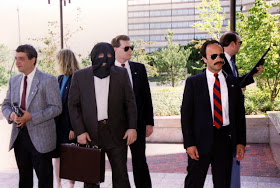[1.] Did You Run?
Your selfie entitled “D’oh!piate of the Masses” with hashtag
#RunRiot may not qualify you as organic Dissident. Dis incident must have dint
of inquiry, straightaway. First of all, hop off the treadmill, Gus. Technically,
yes, you ran, but you ran indoors, and at that, fess up: you engaged Preset #1:
Interpretive Pace to REM’s (This One Goes Out To) “The One I Love.” Until your earbuds
fell out. “(Fiiire!)” Did you sidle? Did
you jaunt? Did you amble or ambulate? You may have skidded and you may have
slid and you may have tripped, jogged, or slipped. “(Fiiire!)” We know that you
click-liked several status updates, never mind your liberal commentary with
devil emoticon. How do we know this? Because Facebook knows, and if Facebook
knows, then the Government knows, too, and since the Government commits itself
to error, I’d look over my shoulder from this point forward. “(Fiiire!)” Hey:
Would you cut off that B****y song!
[2.] Did You Riot?
I know you’re into Occupy, but if you’re gonna Occupy the
john, can you at least lock the door, so the john reads Occupied? You do have
options by the by. Port Authority and Port-A-Potty now offer Port-A-Pottery: a
21st Century slop jar for the Occupier on the go. Or, rather, the
Occupier who has to go. Available now
at Port-A-Pottery Barn. But we digress. Let’s move on to the results of your
French Test, for, in order to riot, you must demonstrate simple Franco-phony
competency. I regret to inform you that Emile Zola did not publish an article
entitled “J’appose.” He did not write about human thumbs and he did not
consider himself part of the Apposition. Have you opposed? Have you vetoed?
Have you vetoed the line? Have you headbutted detritus? Have you denounced
gentrification? Maybe you declared a point of order. Maybe you skipped dessert.
Maybe, just maybe, you posted negative feedback in your native hemisphere, but
are you a riot?
[3.] Did You Run Riot?



